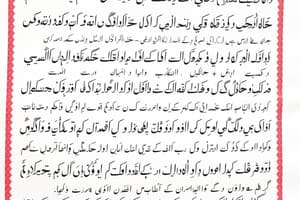Podcast
Questions and Answers
What script is used for writing Urdu?
What script is used for writing Urdu?
- Nastaliq (correct)
- Latin
- Devanagari
- Cyrillic
Which of the following is NOT a significant influence on the development of Urdu?
Which of the following is NOT a significant influence on the development of Urdu?
- Persian
- Arabic
- Turkish
- Japanese (correct)
Which dialect of Urdu is primarily known for its poetic form?
Which dialect of Urdu is primarily known for its poetic form?
- Bhojpuri
- Dakhni
- Hindustani
- Rekhta (correct)
Approximately how many native speakers of Urdu are there?
Approximately how many native speakers of Urdu are there?
Which of the following is NOT a genre found in Urdu literature?
Which of the following is NOT a genre found in Urdu literature?
Flashcards are hidden until you start studying
Study Notes
Overview of Urdu
- Indo-Aryan language primarily spoken in Pakistan and India.
- National language of Pakistan and one of the 22 scheduled languages of India.
- Written in a modified form of the Perso-Arabic script called Nastaliq.
Historical Background
- Originated from the Indo-Aryan languages during the Mughal era.
- Influenced by Persian, Arabic, Turkish, and local languages.
- Developed as a lingua franca among various ethnicities in South Asia.
Linguistic Characteristics
- Uses a rich vocabulary, combining native Hindustani words with borrowings from Persian and Arabic.
- Grammatically similar to Hindi, with differences in script and vocabulary.
- Dialects include Dakhni (from Deccan), Rekhta (poetic form), and others.
Cultural Significance
- Prominent in poetry, literature, music, and cinema.
- Famous poets include Ghalib, Iqbal, and Faiz Ahmed Faiz.
- Urdu literature encompasses various genres such as ghazal, nazm, and prose.
Current Status
- Approx. 70 million native speakers, with many more as a second language.
- Official language status in Pakistan, with robust educational and media presence.
- Continued evolution influenced by globalization and technology.
Learning Urdu
- Key components include vocabulary acquisition, grammar, and pronunciation.
- Resources include language courses, online platforms, and literature.
- Engaging with Urdu media (films, music, and literature) enhances comprehension and fluency.
Overview of Urdu
- Urdu is an Indo-Aryan language, the national language of Pakistan and one of 22 scheduled languages of India.
- It's written in Nastaliq, a modified form of the Perso-Arabic script.
Historical Background
- Urdu originated from Indo-Aryan languages during the Mughal era.
- It was influenced by Persian, Arabic, Turkish, and local languages.
- Urdu emerged as a lingua franca among various ethnicities in South Asia.
Linguistic Characteristics
- Urdu uses a rich vocabulary blending native Hindustani words with borrowings from Persian and Arabic.
- Its grammar is similar to Hindi, with differences in script and vocabulary.
- Notable dialects include Dakhni (from Deccan) and Rekhta (poetic form).
Cultural Significance
- Urdu holds a prominent place in poetry, literature, music, and cinema.
- Famous poets include Ghalib, Iqbal, and Faiz Ahmed Faiz.
- Urdu literature spans diverse genres such as ghazal, nazm, and prose.
Current Status
- Approximately 70 million people are native Urdu speakers, with many more using it as a second language.
- Urdu is the official language of Pakistan with a strong educational and media presence.
- It continues to evolve, shaped by globalization and technology.
Learning Urdu
- Key components of learning Urdu include vocabulary acquisition, grammar, and pronunciation.
- Resources include language courses, online platforms, and literature.
- Engaging with Urdu media (films, music, and literature) enhances comprehension and fluency.
Studying That Suits You
Use AI to generate personalized quizzes and flashcards to suit your learning preferences.




